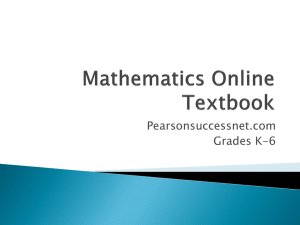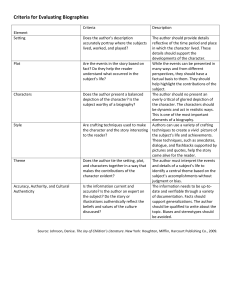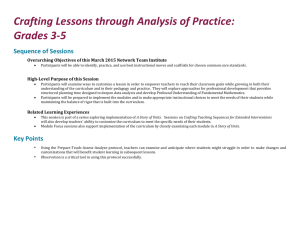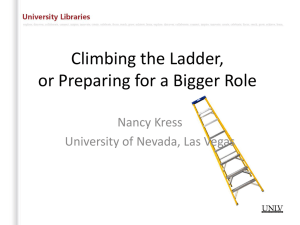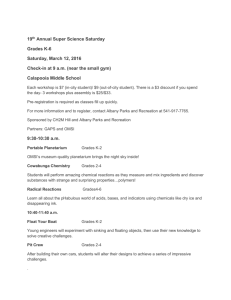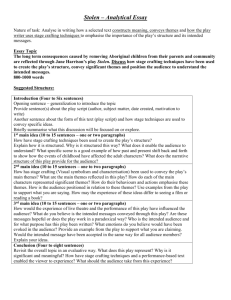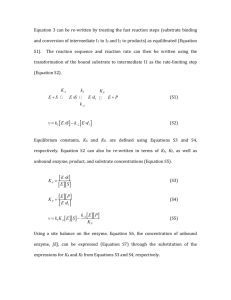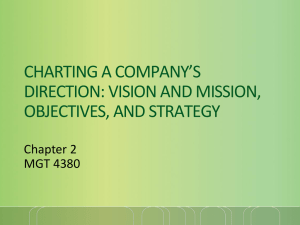Crafting Lessons Through Analysis of Practice Grades
advertisement
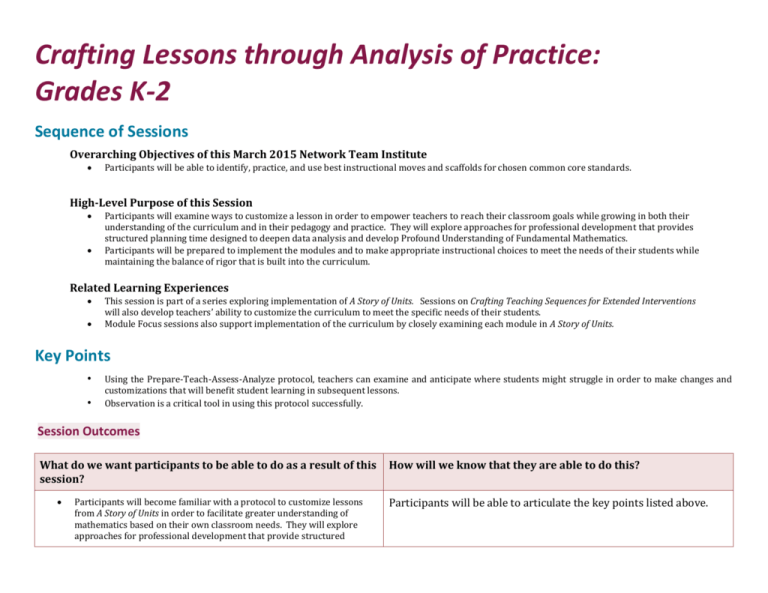
Crafting Lessons through Analysis of Practice: Grades K-2 Sequence of Sessions Overarching Objectives of this March 2015 Network Team Institute Participants will be able to identify, practice, and use best instructional moves and scaffolds for chosen common core standards. High-Level Purpose of this Session Participants will examine ways to customize a lesson in order to empower teachers to reach their classroom goals while growing in both their understanding of the curriculum and in their pedagogy and practice. They will explore approaches for professional development that provides structured planning time designed to deepen data analysis and develop Profound Understanding of Fundamental Mathematics. Participants will be prepared to implement the modules and to make appropriate instructional choices to meet the needs of their students while maintaining the balance of rigor that is built into the curriculum. Related Learning Experiences This session is part of a series exploring implementation of A Story of Units. Sessions on Crafting Teaching Sequences for Extended Interventions will also develop teachers’ ability to customize the curriculum to meet the specific needs of their students. Module Focus sessions also support implementation of the curriculum by closely examining each module in A Story of Units. Key Points • • Using the Prepare-Teach-Assess-Analyze protocol, teachers can examine and anticipate where students might struggle in order to make changes and customizations that will benefit student learning in subsequent lessons. Observation is a critical tool in using this protocol successfully. Session Outcomes What do we want participants to be able to do as a result of this session? Participants will become familiar with a protocol to customize lessons from A Story of Units in order to facilitate greater understanding of mathematics based on their own classroom needs. They will explore approaches for professional development that provide structured How will we know that they are able to do this? Participants will be able to articulate the key points listed above. planning time designed to deepen data analysis and develop Profound Understanding of Fundamental Mathematics. Participants will be prepared to implement the modules and to make appropriate instructional choices to meet the needs of their students while maintaining the balance of rigor that is built into the curriculum. Session Overview Section Time Overview 8 min Introduces this session on how to use a system of thorough analysis to help craft lessons. Prepared Resources • Introduction • • 79 min Explores the “Prepare – Teach – Assess – Analyze” protocol. 88 min Explores the tool of observation and the role it plays in shaping learning. Using a Second Lesson to Fine-Tune Working with the Protocol 84 min Repeats the earlier process in order to practice applying the protocol and adding any customizations or short-term interventions that might be necessary. Observation Revisited 67 min Repeats the observation process with the second lesson to further Using the Protocol • • Observation • • • • Crafting Lessons through Analysis, Grade K-2 PPT Crafting Lessons through Analysis, Grade K-2 Facilitator Guide Crafting Lessons through Analysis, Grade K-2 PPT Crafting Lessons through Analysis, Grade K-2 Facilitator Guide Crafting Lessons through Analysis, Grade K-2 PPT Crafting Lessons through Analysis, Grade K-2 Facilitator Guide Crafting Lessons through Analysis, Grade K-2 PPT Crafting Lessons through Analysis, Grade K-2 Facilitator Guide Crafting Lessons through Analysis, Grade K-2 PPT Facilitator Preparation Review Crafting Lessons through Analysis, Grades K-2 PPT and Facilitator Guide Review Crafting Lessons through Analysis, Grades K-2 PPT and Facilitator Guide Review Crafting Lessons through Analysis, Grades K-2 PPT and Facilitator Guide Review Crafting Lessons through Analysis, Grades K-2 PPT and Facilitator Guide Review Crafting Lessons through Analysis, Grades K-2 PPT and explore the concepts of this session. 45 minutes Conclusion Concludes the session by exploring ways to use the protocol practiced and information gathered to help create a plan for implementation of these structures, cycles, practices, and concepts. • Crafting Lessons through Analysis, Grade K-2 Facilitator Guide • Crafting Lessons through Analysis, Grade K-2 PPT Crafting Lessons through Analysis, Grade K-2 Facilitator Guide • Facilitator Guide Review Crafting Lessons through Analysis, Grades K-2 PPT and Facilitator Guide Session Roadmap Section: Introduction Time: 8 minutes In this section, you will begin to explore how to craft lessons by going through a thorough analysis of sample lessons. Materials used include: • Crafting Lessons through Analysis, Grades K-2 PPT • Crafting Lessons through Analysis, Grades K-2 Facilitator Guide • Crafting Lessons through Analysis. Grades K-2 Handout Time Slide # Slide #/ Pic of Slide 1. Script/ Activity directions Put 2 copies of the Observation Recording Sheet for each participant in one pile face down under the materials basket of the table. 2 copies of Appendix A on the table per participant 2 copies of Appendix B on the table per participant. GROUP 8 min 2. 8 minutes for the slide. Poll. Raise a straight arm if: • You are a Kindergarten classroom teacher. 1st grade. 2nd grade. Student teacher. • You are a math coach. Coordinator. Resource teacher. • You are a school-level administrator. District-level administrator. • You are using the lessons on a daily basis. To supplement your instruction. Directions to the Facilitator. Establish a signal such as hand clapping to return to unify the group. 1) Have participants stand. 2) Reflective Question: “How have you been supported in analyzing and improving your teaching craft or practice? How effective has that support been?” 3) Ask the participants to find a partner at a different table with whom to share for 1.5 minutes their experience (Signal to change partners.) 4) As participants share, circulate and possibly pass out Share it! Cards. Section: Using the Protocol Time: 79 minutes In this section, you will begin to explore the “Prepare – Teach – Assess – Analyze” protocol. Materials used include: • Crafting Lessons through Analysis, Grades K-2 PPT • Crafting Lessons through Analysis, Grades K-2 Facilitator Guide • Crafting Lessons through Analysis. Grades K-2 Handout Time Slide # Slide #/ Pic of Slide Script/ Activity directions GROUP 9 min 3. • • • • 2 minutes to read and understand the protocol 2 minutes to read 3 minutes for the protocol 2 minutes to share out whole group, answer questions. Directions: Have participants use Protocol A, Save the Last Word for Me to read page 2, “Welcome to Crafting Lessons Through Analysis of Teaching Practice” of their participant packet in triads. 2 min 4. Directions • Introduce the teacher and express gratitude! Marianne Strayton is an educator from New York City, New York. She currently teaches second grade and works with various other elementary grade levels in before and after school programs. Along with her full-time classroom position, Marianne is a writer and editor of Eureka Math curriculum from Great Minds. Over here last 17 years in the profession, she has taught various elementary grades and has held the position for Math & Science Coordinator, K-12 for a district which serves over 9,000 students across 16 schools. She loves the collaborative process of learning, whether with her students, fellow teachers, or her nieces and nephews. Marianne’s degrees include a B.A. in Elementary Education and Psychology from Saint Michael’s College, an M.S. in Elementary STEM Education from Iona College, and Ed.D. in Educational Leadership and Teacher Education with the Curriculum & Teaching department at Teachers College, Columbia University. She holds certifications in elementary education, gifted education, and administration. 20 min 5. • • • • • A - 4 minutes B - 4 minutes C - 2 minutes D - 5 minutes Whole Group shares out (5 minutes) The first lesson that we will study is from Grade 2, Module 5 Lesson 16 on subtraction. A: Remembering the preparation process as detailed in Appendix D: Preparing to Teach a Lesson from A Story of Units, complete the Problem Set to be done by students. B: Study and write notes on the complexities of each problem and read through the Student Debrief questions. C: Anticipate where students might struggle. D: Briefly study the entire lesson, how does it lead to students’ independent success. What customizations might you consider? Share out whole group. 4 min 6. A: Silently read through Appendix A’s Part 1: Pre-Instruction Preparation with Deliberate Practice and Part 2: Post-Instruction Reflection with Deliberate Practice. Share thoughts within a partner or triad. (4 minutes) . Facilitator, clarify any confusion. 16 min 7. 16 minutes • A - 7 minutes • B - 2 minutes • C - 3 minutes • Whole Group shares out (4 minutes) Part 2: Prepare through collaboration and practice. A: Watch a pre-conference while making notes on Appendix A Part 1: PreInstruction Preparation with Deliberate Practice. B: After viewing, use your notes to review what took place in the conference with a partner. C: Consider with a partner the various ways in which the conference may have advanced the teacher’s preparation and practice. Refer back to the curriculum to support your analysis. • 28 min 8. • • • • • • Share out whole group. A - 8 minutes B - 2 minutes C - 3 minutes D - 3 minutes E - 8 minutes Whole Group shares out 4 minutes Part 4: Assess, analyze, and collaborate. A: Watch the post-conference making notes on the post conference form. (8 minutes) B: Compare notes with a colleague reconstructing what took place in the post conference. (2 minutes) C: The coach made an effort to get into the specifics of the mathematics and how precisely it was taught. What evidence is there in the post conference of that effort? How did the dialogue’s move to precision and specificity change the conference? (3 minutes) D: Read through Appendix F: Deliberate Practice. E: Deliberately practice the same component modeled by the teacher. Use the protocol to practice the same component in pairs or triads. (8 minutes) Whole Group shares out. Section: Observation Time: 88 minutes In this section, you will begin to explore the tool of observation and Materials used include: the role it plays in shaping learning. • Crafting Lessons through Analysis, Grades K-2 PPT • Crafting Lessons through Analysis, Grades K-2 Facilitator Guide • Crafting Lessons through Analysis. Grades K-2 Handout Time Slide # Slide #/ Pic of Slide Script/ Activity directions 6 min A - 3 minutes B - 3 minutes 9. A: Silently read through Appendix B: Part 1: Interview focused on the Teacher’s Preparation and Part 2: Documentation of the Observer’s Learning. B: Discuss the ways in which Appendix B is distinct from Appendix A within a partner or triad. Watch a small video of the teacher modeling from Part 1(c): Interview focused on the Teacher’s Preparation. GROUP 30 min 10. • • • • • • • A - 1 minutes B - 10 minutes C - 5 minutes D - 5 minutes E - 6 minutes (3 for writing and 3 for sharing) Optional deliberate practice for 6 minutes. Whole Group shares out 3 minutes Observe part 1 of a Eureka lesson. (30 minutes) A: Take on the role of a sports reporter using Appendix C: Observation Recording Sheet. B: Watch the video while taking notes on the Fluency and Application Problem components. C: Review observation notes from beginning to end with a colleague recreating the action of the lesson from the notes. (Request replays if desired.) Also reflect on the experience of taking the notes. D: Refer back to the Fluency and Application Problem of the curriculum and make notes directly on the curriculum about the customizations made by the teacher. Compare the actual classroom experience to what is in the curriculum and to what the teacher proposed in the pre-conference. E: Silently write about student learning that took place and the specific teacher actions and words that made it successful. Write down what you would like to incorporate into your own practice, with a focus on the mathematics rather than management. Share out writing in small groups. Optional: Deliberately practice something the teacher wants to incorporate into his or her own practice from the fluency or application problem. 22 min 11. • • • • A - 10 minutes B - 4 minutes C - 5 minutes Whole Group shares out 3 minutes Observe part 2 of a Eureka lesson. (22 minutes) A: Watch and take notes on the Concept Development, Problem Set, and Debrief. B: Review your observation notes from beginning to end with a colleague recreating the action of the lesson from the notes. (Request replays if desired.) Also reflect on the experience of taking the notes. C: Refer back to the Concept Development, Problem Set, and Debrief of the curriculum and make notes directly on the curriculum about the customizations. Compare the actual classroom experience to what is in the curriculum and to what the teacher proposed in the pre-conference. 30 min 12. • • • • • • A - 5 minutes B - 5 minutes C - 4 minutes D - 4 minutes E - 8 minutes Whole Group shares out 4 minutes Analyze the Exit Tickets: Use Appendix B: Part 2: Documentation of the Observer’s Learning. (30 minutes) A: Distribute the Exit Tickets equally. In order to get an overview of the work, pass the set forward every 30 seconds until the set has moved around the table. At the end, keep those you end up with. B: Analyze your student work within a triad. Record your response to Appendix B: Documentation of the Observer’s Learning Part 2a. Think back to the lesson using your notes and reference the curriculum to detail what moments of instruction may have contributed to the strength exhibited in the exit tickets? C: What specific errors are evidenced in each sample? Record your response to Appendix B: Documentation of the Observer’s Learning Part 2b. Again, think back to the lesson using both your notes and reference the curriculum to detail what specific moments of instruction may have contributed to the weaknesses exhibited in the exit tickets? D: Record your response to Appendix B: Documentation of the Observer’s Learning Part 2c. E: Culminate Part 3 by deliberate practice as described in Appendix B: Documentation of the Observer’s Learning Part 2: Closing Action. Section: Using a Second Lesson to Fine-Tune Working with the Protocol Time: 84 minutes In this section, you will repeat the earlier process in order to practice applying the protocol and adding any customizations or short-term interventions that might be necessary. Materials used include: • Crafting Lessons through Analysis, Grades K-2 PPT • Crafting Lessons through Analysis, Grades K-2 Facilitator Guide • Crafting Lessons through Analysis. Grades K-2 Handout Time Slide Slide #/ Pic of Slide # Script/ Activity directions GROUP 25 min 13. • • • • • A - 8 minutes B - 3 minutes C - 5 minutes D - 5 minutes Whole Group shares out 4 minutes Prepare a subsequent lesson. A: Remembering the preparation process as detailed in Appendix D: Preparing to Teach a Lesson from A Story of Units, complete and analyze the Problem Set to be done by students. B: What do you know from the prior lesson that may mean customizations and short-term interventions? Tweak or replace a fluency or any lesson component to meet the needs of the students in the observed teacher’s classroom or in your own classroom. C: Deliberately practice a component that reflects a customization. 1 min 14. Explain that we are going to begin the cycle again. 2 min 15. 15 min 16. Read Melanie’s bio. • • • • • A - 2 minutes B - 3 minutes C - 2 minutes D - 5 minutes Whole Group shares out (3 minutes) The second lesson that we will study is Kindergarten Module 4 Lesson 13. A: Remembering the preparation process as detailed in Appendix D: Preparing to Teach a Lesson from A Story of Units, complete the Problem Set to be done by students. B: Study and write notes on the complexities of each problem and read through the Student Debrief questions. C: Anticipate where students might struggle. D: Briefly study the entire lesson, how does it lead to students’ independent success. What customizations might you consider? Share out whole group. 1 min 17. Remind participants of Appendix A’s Part 1: Pre-Instruction Preparation with Deliberate Practice and Part 2: Post-Instruction Reflection with Deliberate Practice. Share thoughts within a partner or triad. (4 minutes). Facilitator, clarify any confusion. 16 min 18. • • • • A - 7 minutes B - 2 minutes C - 3 minutes Whole Group shares out (4 minutes) Part 2: Prepare through collaboration and practice. A: Watch a pre-conference while making notes on Appendix A Part 1: Pre-Instruction Preparation with Deliberate Practice. B: After viewing, use your notes to review what took place in the conference with a partner. C: Consider with a partner the various ways in which the conference may have advanced the teacher’s preparation and practice. Refer back to the curriculum to support your analysis. • Share out whole group. 20 min 19. • A - 6 minutes • B - 2 minutes • C - 3 minutes • D - 6 minutes • Whole Group shares out 3 minutes • Part 4: Assess, analyze, and collaborate. A: Watch the post-conference making notes on the post conference form. (6 minutes) B: Compare notes with a colleague reconstructing what took place in the post conference. (2 minutes) C: The coach made an effort to get into the specifics of the mathematics and how precisely it was taught. What evidence is there in the post conference of that effort? How did the dialogue’s move to precision and specificity change the conference? (3 minutes) D: Deliberately practice the same component modeled by the teacher. Use the protocol to practice the same component in pairs or triads. (8 minutes) Whole Group shares out. Section: Observation Revisited Time: 67 minutes In this section, you will repeat the observation process with the second lesson to further explore the concepts of this session. Materials used include: • Crafting Lessons through Analysis, Grades K-2 PPT • Crafting Lessons through Analysis, Grades K-2 Facilitator Guide • Crafting Lessons through Analysis. Grades K-2 Handout Time Slide # Slide #/ Pic of Slide Script/ Activity directions GROUP 20. 25 min 21. 1. Remind participants of the distinct recording sheet, Appendix B. • • • • • • A - 7 minutes B - 4 minutes C - 3 minutes D - 4 minutes (2 for writing and 2 for sharing) Optional deliberate practice for 6 minutes. Whole Group shares out 3 minutes Observe part 1 of a Eureka lesson. (30 minutes) A: Take on the role of a sports reporter using Appendix C: Observation Recording Sheet. Watch the video while taking notes on the Fluency and Application Problem components. B: Review observation notes from beginning to end with a colleague recreating the action of the lesson from the notes. (Request replays if desired.) Also reflect on the experience of taking the notes. D: Refer back to the Fluency and Application Problem of the curriculum and make notes directly on the curriculum about the customizations made by the teacher. Compare the actual classroom experience to what is in the curriculum and to what the teacher proposed in the pre-conference. E: Silently write about student learning that took place and the specific teacher actions and words that made it successful. Write down what you would like to incorporate into your own practice, with a focus on the mathematics rather than management. Share out writing in small groups. Optional: Deliberately practice something the teacher wants to incorporate into his or her own practice from the fluency or application problem. 22 min 22. • • • • A - 10 minutes B - 4 minutes C - 5 minutes Whole Group shares out 3 minutes Observe part 2 of a Eureka lesson. (22 minutes) A: Watch and take notes on the Concept Development, Problem Set, and Debrief. B: Review your observation notes from beginning to end with a colleague recreating the action of the lesson from the notes. (Request replays if desired.) Also reflect on the experience of taking the notes. C: Refer back to the Concept Development, Problem Set, and Debrief of the curriculum and make notes directly on the curriculum about the customizations. Compare the actual classroom experience to what is in the curriculum and to what the teacher proposed in the pre-conference. 20 min 23. • • • • • • A - 3 minutes B - 3 minutes C - 3 minutes D - 3 minutes E - 6 minutes Whole Group shares out 2 minutes Analyze the Exit Tickets: Use Appendix B: Part 2: Documentation of the Observer’s Learning. (30 minutes) A: Distribute the Exit Tickets equally. In order to get an overview of the work, pass the set forward every 30 seconds until the set has moved around the table. At the end, keep those you end up with. B: Analyze your student work within a triad. Record your response to Appendix B: Documentation of the Observer’s Learning Part 2a. Think back to the lesson using your notes and reference the curriculum to detail what moments of instruction may have contributed to the strength exhibited in the exit tickets? C: What specific errors are evidenced in each sample? Record your response to Appendix B: Documentation of the Observer’s Learning Part 2b. Again, think back to the lesson using both your notes and reference the curriculum to detail what specific moments of instruction may have contributed to the weaknesses exhibited in the exit tickets? D: Record your response to Appendix B: Documentation of the Observer’s Learning Part 2c. E: Culminate Part 3 by deliberate practice as described in Appendix B: Documentation of the Observer’s Learning Part 2: Closing Action. Section: Conclusion Time: 25 minutes In this section, you will conclude the session by exploring ways to Materials used include: use the protocol practiced and information gathered to help create a • Crafting Lessons through Analysis, Grades K-2 PPT plan for implementation of these structures, cycles, practices, and • Crafting Lessons through Analysis, Grades K-2 Facilitator Guide concepts. • Crafting Lessons through Analysis. Grades K-2 Handout Time 15 min Slide # Slide #/ Pic of Slide 24. Script/ Activity directions • • • A - 5 minutes B - 8 minutes Whole Group shares out 3 minutes Menu of Options Plan the subsequent lesson. Collaboratively consider how best to return to your school sites and GROUP implement some or all of these structures, cycles, practices, and concepts. Plan a lesson collaboratively to use with the process for your own school or district. Prepare for the pre-conference as both teacher and administrator. This would include digging into deliberate practice. 10 min 25. It has been suggested that courage is fear transformed. In light of this, take a moment to reflect in writing about the following considerations. Share your observations with your partner. Use the following icons in the script to indicate different learning modes. Video Reflect on a prompt Active learning Turn and talk Turnkey Materials Provided Crafting Lessons through Analysis of Practice, Grades K-2 PPT Crafting Lessons through Analysis of Practice, Grades K-2 Facilitator Guide Crafting Lessons through Analysis of Practice, Grades K-2 Handout Additional Suggested Resources How to Implement A Story of Units A Story of Units Year Long Curriculum Overview A Story of Units CCLS Checklist
